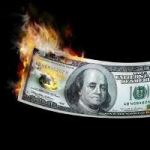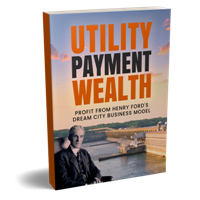 “Gold is money. Everything else is credit.”
“Gold is money. Everything else is credit.”
– J.P. Morgan, testimony before Congress in 1912
Impossible Imbalances
There has been a lot of discussion lately about America’s massive trade deficit and how President Trump’s tariff policies are intended to shrink it down while returning manufacturing to the USA. What isn’t often mentioned is how this massive trade deficit ever came about to the extent that it has to begin with. If the world still operated on a gold standard these mega imbalances would have been impossible.
Consider a world where every dollar, yen, or euro was backed by a real, physical piece of gold in a vault. That’s the gold standard. In this system, if the U.S. wanted to buy more goods from other countries than it was selling, it would have to pay in gold. That means gold would be flowing out of the U.S. and into the hands of its trading partners.
As the U.S. gold reserves dwindled, the amount of dollars in circulation would shrink, making dollars more valuable. At the same time, the countries receiving all that gold would see their money supply grow, making their currencies less valuable.
This process would naturally correct the trade imbalance. U.S. goods would become cheaper for foreigners, and their goods would become more expensive for Americans. This would encourage a natural shift back towards balance. A massive, long-term trade deficit would be impossible because a country would eventually run out of gold.
But in today’s world of fiat currency, money isn’t backed by anything tangible or of limited supply. Its value is based on trust in the government that issues it. This is where things get out of hand. The U.S., having the exorbitant privilege of the world reserve currency, can run a huge trade deficit, buying way more from foreigners than it sells, for a very long time.
This is because the U.S. can essentially pay for its imports with its own fiat. The rest of the world is willing to accept U.S. dollars in exchange for their goods and services because they know they can use those dollars to buy other things, like U.S. Treasury bonds or stocks.
Rather than shipping out gold, we’re shipping out paper (or digital) dollars. Thus, the money never runs out. This allows us to keep buying and buying, racking up a massive trade deficit without the automatic, gold-driven correction of the past. Over many decades, this has created a condition that is grossly out of balance.
Trump, for his part, is the first president with the gumption to do something about it. Unfortunately, his solution – tariffs – is like trying to control diarrhea with duct tape. It turns one messy situation into another.
Fiscal discipline, like a balanced budget and a stable money supply, would go a long way to shrink America’s trade deficit. This, however, would go against an attitude of fiscal and monetary prolificacy that has been engrained in the U.S. government for well over 100 years – perhaps longer.
Let’s explore…
FDR’s Gold Grab
In 1933, in the dark days of the Great Depression, heavy-handed action was taken by the federal government. Banks were failing, unemployment was soaring, and President Franklin D. Roosevelt was compelled to do something.
The country was operating on a gold standard, where the dollar was redeemable for a fixed amount of gold. Rational and prudent people, concerned by the economic collapse, were rightfully hoarding gold coins and bullion. They trusted gold more than they trusted the banks.
FDR and his administration, however, didn’t like this. They believed the hoarding was crippling the economy and preventing the Federal Reserve, which had come into existence in 1913, from injecting more money into the system.
Their solution? A radical, unprecedented step.
On April 5, 1933, FDR issued Executive Order 6102. This order made it illegal for private citizens to own monetary gold, including gold coins and bullion. People were given a short window to turn in their gold to the U.S. government in exchange for paper currency at a set price of $20.67 per troy ounce.
This, without question, was a massive violation of property rights and a fundamental attack on sound money. When FDR confiscated people’s gold, it stripped away the little guys’ most reliable and independent store of value. Moreover, it forced them to use a government-backed fiat currency, making them more dependent on the state and its central bank.
The government’s goal with this gold confiscation was to devalue the dollar. After the confiscation, they raised the official price of gold to $35 per ounce in 1934, effectively devaluing the dollar by about 40 percent. This also made it easier to inflate the money supply. The U.S. government, in essence, defaulted on the dollar by changing the terms and conditions of both the dollar’s content and value.
Nixon Closes the Gold Window (Happy 54th Anniversary)
Fast forward a few decades to the post-World War II era. In 1944, the world’s leading economic powers met in Bretton Woods, New Hampshire, to create a new global monetary system.
The Bretton Woods Agreement established a system where the U.S. dollar was pegged to gold at $35 per ounce, and other world currencies were pegged to the dollar. This created a pseudo gold standard, where only foreign central banks could redeem their dollars for gold from the U.S. Treasury. This made the dollar the world’s primary reserve currency.
This system worked for a while. But it didn’t work very well. The U.S. was the world’s dominant economic power. Countries were content to hold dollars. Over time, the U.S. government lost its fiscal disciple. Uncle Sam started to print more and more money to fund guns and butter social programs and the Vietnam War.
This led to a problem that could not be ignored. The U.S. government was issuing far more dollars than it had gold to back them. Foreign central banks, especially France under Charles de Gaulle, grew suspicious. They began to demand gold in exchange for all the dollars they were accumulating. This quickly became a drain on America’s gold reserves.
Naturally, the Bretton Woods Agreement was doomed from the get-go. Any system where a central authority (in this case, the U.S. government) has the power to print money without a strict commodity anchor is inherently unstable. Governments will always be tempted to spend more than they have, leading to inflation and, eventually, a currency crisis.
The crisis came to a head on August 15, 1971 – exactly 54 years ago today. Facing a run on America’s gold, President Richard Nixon went on national television and announced a “temporary” suspension of the dollar’s convertibility to gold. On this important anniversary, take a moment to watch this brief clip of overt statism.
This move, which would later be known as “closing the gold window,” effectively ended the Bretton Woods system and any direct link between the U.S. dollar and gold. The dollar became a pure fiat currency. Money that has value only because the government says it does.
Through changing the terms and conditions, the U.S. government once again defaulted on the dollar.
A World of Fiat
So, here we are, in a world where every major currency is fiat. We use dollars, euros, and yen with no physical backing. What does this mean for us today?
One major impact is that our money is now a political tool. Without the discipline of a gold standard, central banks can create as much money as they want.
This power, while championed by central planners as a way to manage the economy, is the primary engine of inflation. Every new dollar printed dilutes the value of all the existing dollars. This acts as a hidden tax on everyone who holds dollars. It’s why your grandparents could buy a soda for a nickel, and you can’t.
This constant injection of new money also leads to a boom-and-bust cycle. By manipulating interest rates and expanding the money supply, central banks create artificial booms. But because these booms are based on malinvestment – bad investments made possible by cheap credit – they are unsustainable. Eventually, the bubble bursts, leading to a recession.
From FDR’s seizure of private gold to Nixon’s severing of the final link between the dollar and gold, these events weren’t just political maneuvers. They were fundamental shifts that changed the nature of money itself and eroded financial independence.
In a world of fiat, our financial lives are at the mercy of political decisions and the printing press. Your money isn’t really yours.
This is very different from the independent, market-based money of a true gold standard. Alas, we all live with the savage consequences.
[Editor’s note: Have you ever heard of Henry Ford’s dream city of the South? Chances are you haven’t. That’s why I’ve recently published an important special report called, “Utility Payment Wealth – Profit from Henry Ford’s Dream City Business Model.” If discovering how this little-known aspect of American history can make you rich is of interest to you, then I encourage you to pick up a copy. It will cost you less than a penny.]
Sincerely,
MN Gordon
for Economic Prism




